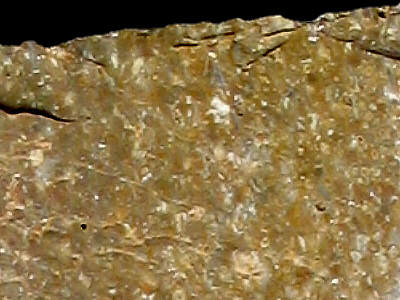
Foto: Jehanne Féblot-Augustins, 2005.
- Balme à Juliette 1
- Le Plan
Sampled sites:
| Material name: | Bj4c |
| Synonyms: | N/A |
| Material (geologic): | Middle Jurassic (Dogger, Late Bajocian) flint. |

Foto: Jehanne Féblot-Augustins, 2005. |
Sampled sites:
|
| Mode of occurrence: | Occurring in continuous beds 5 to 6 cm thick, highly jointed, jutting out from the compact light brownish grey to light reddish tan limestone. Lower layers of an outcrop at the top of a cliff face. |
| Cortex: | Fresh, rough, light pinkish tan, 0.5 cm, transition sharp. |
| Colour: | Dark reddish brown (5YR 3/2). |
| Pattern: | Abundantly flecked with pale-coloured specks. |
| Appearance: | Homogeneous material, although highly jointed, dull and opaque, moderately smooth, medium-grained. |
| Structure: | Faintly laminated, with a fluidal arrangement of grains. |
| Texture: | Grainstone. |
| Matrix: | - |
| Grains: | 90 %, pale or more generally highly impregnated by iron oxides, rounded with high sphericity, a few cubic elements; main grain size 500 µ (ooliths), with others ranging between 1000 µ and 2-3 mm. |
| Grain composition: | Mainly ooliths, plus pelecypod fragments, sea urchin radioles, entrochi, serpulid sections, and numerous Cyclostoma bryozoans; a few clasts. |
| Further information: | Click here for the original French description (opens in a new window), or here for more information on the attributes used in the description (use your browser's "BACK"-button to return here). |
| Citing: | Information on citing this page can be found here. |
| Locality: | Ambérieu-en-Bugey / Les Balmeaux - Balme à Juliette 1, France, Ain department |
| Synonyms: | Sampling site Bugey 4 after Féblot-Augustins |
| Geographical description: | The sample was taken from the lower flint-layers at the top of a cliff approx. 1 kilometre to the east of Vareille, a hamlet at the eastern side of Ambérieu-en-Bugey. For a more precise explanation of the local situation, see the description under Bt4 |
| Geographical co-ordinates: |
east/x 836.4 north/y 2111 (Lambert zone II, NTF)
This corresponds roughly with |
| Co-ordinate precision: |
The coordinates given were taken from a large-scale map, and are within 50 metres of the actual exposure. The latitude/longitude coordinates are a direct transformation of these data on WGS84 and are accurate to the same level. The high precision to the second is given to prevent the introduction of a rounding-error. The location can be found on the 1:25 000 topographical map sheet 3130 E of the French Institut Géographique National. |
| Geology: |
According to the geological map, the parent-rock belongs to unit J1c of late Bajocian age. Map of all sampled localities of Bajocian flint in the Bugey (PDF, 190 KB, opens in new window). |
| Type of source: | Primary. |
| Other types of flint: | This source consists of three seperate banks of flint in a fining-upwards sequence. The lowermost layers yield the grainstone of type Bj4c, described on this page, the middle material is the packstone of type Bj4b and the upper layers contain the Bj4a material, with a wackestone texture. |
thumb.jpg) Foto: Jehanne Féblot-Augustins, 2005 |
thumb.jpg) Foto: Jehanne Féblot-Augustins, 2005 |
|
thumb.jpg) Foto: Jehanne Féblot-Augustins, 2005 |
thumb.jpg) Foto: Jehanne Féblot-Augustins, 2005 |
| Locality: | Ambérieu-en-Bugey / Vareille - Le Plan, France, Ain department |
| Synonyms: | Sampling site Bugey 14 after Féblot-Augustins |
| Geographical description: | The source lies on a hilltop approx. 1 kilometre east of the hamlet St. Germain, a couple of kilometres southeast of Ambérieu-en-Bugey. |
| Geographical co-ordinates: |
east/x 836.4 north/y 2110 (Lambert zone II, NTF)
This corresponds roughly with |
| Co-ordinate precision: |
The coordinates given were taken from a large-scale map, and are within approx. 50 - 100 metres of the actual spot. The latitude/longitude coordinates are a direct transformation of these data on WGS84 and are accurate to the same level, so don't be deceived by the apparently high precision to the second. The location can be found on the 1:25 000 topographical map sheet 3130 E of the French Institut Géographique National. |
| Geology: |
The underground at the sampling-site is a clay-with-flints which resulted from the decalcification of several flint-bearing formations dating to the Bajocian and Bathonian (units J1a-b and J1c from the Bajocian and J2 from the Bathonian). Map of all sampled localities of Bajocian flint in the Bugey (PDF, 190 KB, opens in new window). |
| Type of source: | Secondary. |
| Other types of flint: | Besides type Bj4c, this residual source also yields Late Bajocian flints of the Bj3 variety, as well as Bathonian flints of the types Bt1, Bt4 and Bt. |
thumb.jpg) Foto: Jehanne Féblot-Augustins, 2005 |
| Last modified on: November 15, 2005 |
Contents primarily by: Jehanne Féblot-Augustins |
Comments to: |